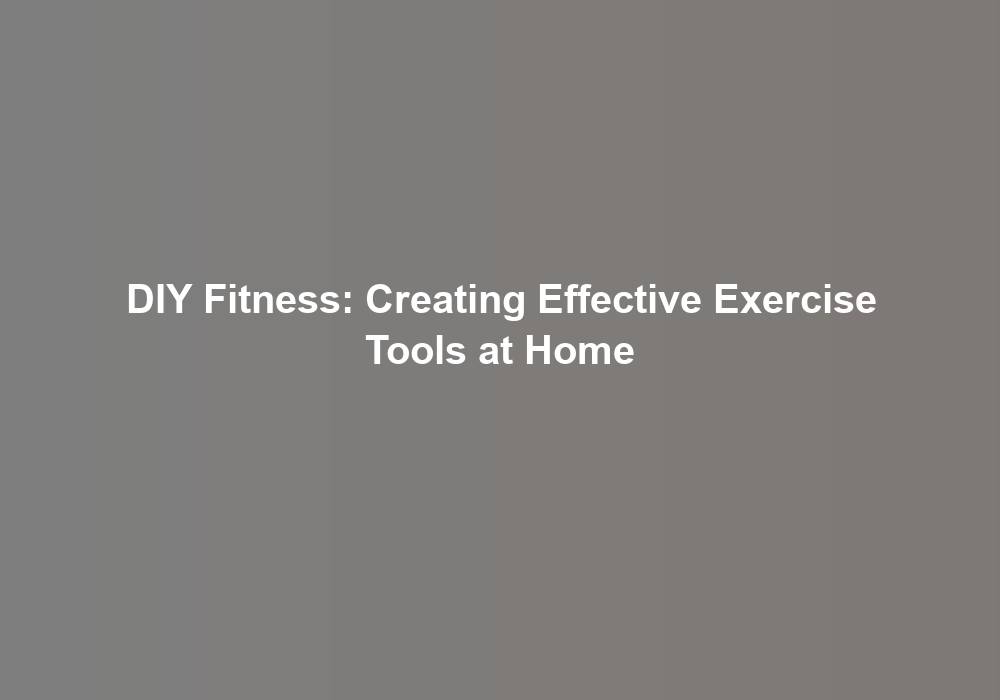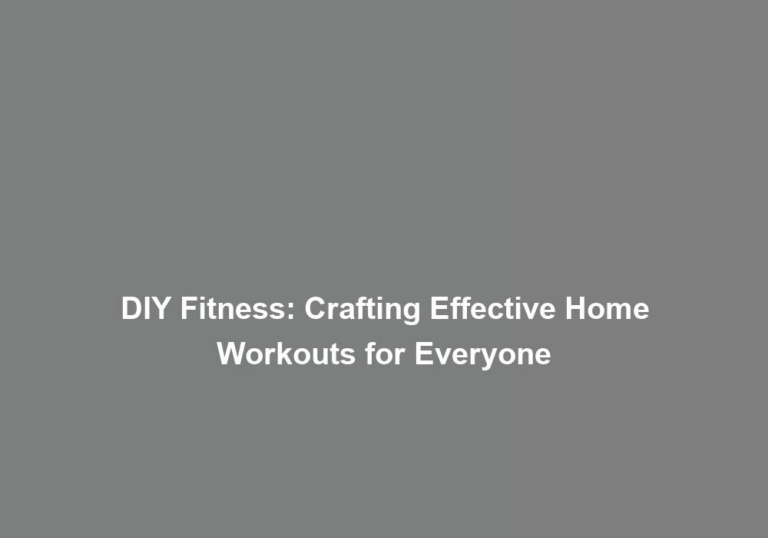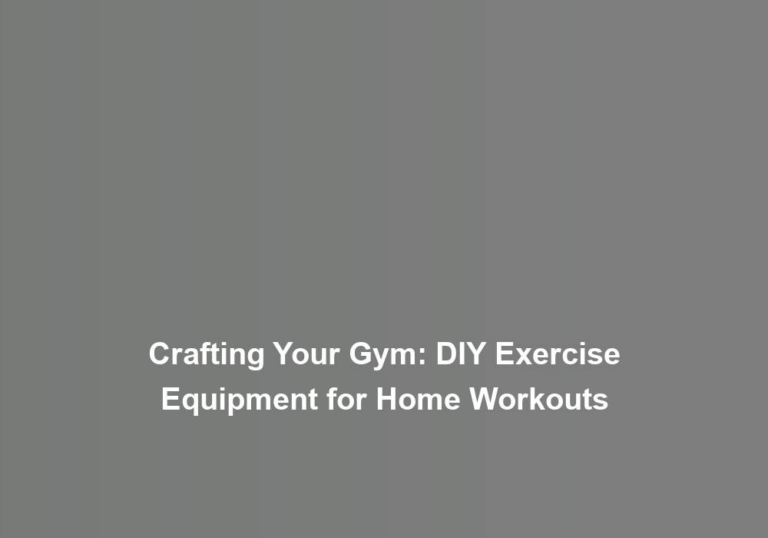DIY Fitness: Creating Effective Exercise Tools at Home
YouG??ve probably heard of the saying G??necessity is the mother of invention.G?? Well, when it comes to staying fit and healthy, thereG??s no need to invest in expensive gym equipment when you can create effective exercise tools right in the comfort of your own home. From homemade weights to DIY suspension trainers, there are numerous ways to elevate your workout routine without breaking the bank. With a little creativity and resourcefulness, you can transform everyday items into functional fitness equipment that will help you achieve your fitness goals. So, why not explore the world of DIY fitness and discover how to craft your own exercise tools that deliver results?
Homemade Weights
You can easily create homemade weights using items found around your home, such as water bottles filled with sand or cans of food. These homemade dumbbells are creative alternatives to traditional gym equipment and can be just as effective for your workouts. By repurposing common household items, you can save money and still achieve your fitness goals.
DIY ankle weights are another great option for adding resistance to your workouts. You can make ankle weights by filling long socks with rice or dried beans and then tying them around your ankles. This simple yet effective solution allows you to customize the weight to your specific needs.
When using homemade weights, itG??s essential to perform exercises that target different muscle groups. Squats, lunges, and bicep curls are effective exercises for homemade dumbbells. For DIY ankle weights, leg lifts, donkey kicks, and bicycle crunches are great choices to strengthen and tone your lower body.
Incorporating homemade weights into your workout routine not only saves you money but also allows you to get creative with your fitness regimen. You can even involve family members in making these homemade exercise tools, promoting a sense of togetherness and accomplishment. With these simple yet effective alternatives, you can enjoy a fulfilling workout experience right in the comfort of your home.
DIY Resistance Bands
Looking to add resistance bands to your home workout routine? There are a variety of materials you can use to create your own DIY resistance bands, from old tights to rubber tubing. Once you have your bands, you can incorporate them into a wide range of exercises to target different muscle groups and add challenge to your workouts.
Material Options for Bands
When creating DIY resistance bands, consider using materials such as nylon webbing, elastic fabric, or rubber tubing to achieve your desired level of resistance. Each material offers unique benefits and can be tailored to your specific needs. Take a look at the table below to compare the different material options for bands:
| Material | Pros | Cons |
|---|---|---|
| Nylon Webbing | Durable, versatile | Less stretchy |
| Elastic Fabric | Stretchy, comfortable | May lose elasticity over time |
| Rubber Tubing | High resistance, long-lasting | Can snap under excessive tension |
DIY Band Exercises
Consider incorporating DIY resistance bands into your workout routine to enhance your strength training and flexibility. DIY resistance bands are versatile and can be used to perform various exercises at home. Here are some tips for maximizing your DIY band exercises:
- Get creative with band modifications to adjust the resistance level for different exercises.
- Utilize different anchor points in your home setup, such as a doorknob or sturdy furniture, to perform a wide range of band exercises.
- Experiment with innovative exercises that target specific muscle groups, such as bicep curls, lateral band walks, and seated rows.
- Incorporate band exercises into your existing workout routine to add variety and challenge your muscles in new ways.
DIY Balance Boards
To create your own DIY balance board at home, you can repurpose a sturdy round wooden board and a PVC pipe to improve your balance and core strength during workouts. Homemade balance boards offer various benefits, such as enhancing stability, coordination, and proprioception. These boards are versatile and can be used for a wide range of exercises, making them a valuable addition to your home gym.
When it comes to DIY balance board designs, there are a few options to consider. One popular design involves attaching a PVC pipe to the center underside of a wooden board. This design allows for 360-degree rotation, providing a dynamic surface for balance training. Additionally, you can customize the length and width of the PVC pipe to adjust the level of difficulty based on your fitness level and goals.
Safety precautions should be taken into account when using a DIY balance board. Ensure that the wooden board is securely attached to the PVC pipe to prevent any instability during use. ItG??s also essential to start with basic exercises and gradually progress to more challenging movements to avoid injury. Using a balance board on a soft surface, such as a yoga mat, can help cushion any falls or slips as you build your proficiency.
Homemade Agility Hurdles
You can easily create homemade agility hurdles using PVC pipes and connectors to enhance your agility and lower body strength for effective at-home workouts. Homemade agility hurdles are a fantastic addition to your DIY fitness arsenal, providing a versatile tool for creating a challenging homemade obstacle course right in your own backyard or living room. HereG??s what you need to know:
-
Affordable Materials: PVC pipes and connectors are affordable and readily available at most hardware stores, making it easy to gather the necessary supplies for your homemade agility hurdles.
-
Customizable Height: With PVC pipes, you can easily adjust the height of your agility hurdles to suit your fitness level and training goals, allowing for progression as you improve your agility and lower body strength.
-
DIY Speed Ladder: Consider combining your homemade agility hurdles with a DIY speed ladder to create a comprehensive agility training setup that will help you improve your footwork, speed, and coordination.
-
Versatile Training Tool: Homemade agility hurdles can be used for a wide range of exercises, from lateral hops and bounding drills to agility drills and plyometric exercises, providing a full-body workout that targets multiple muscle groups.
DIY Plyometric Boxes
Enhance your plyometric training by incorporating DIY plyometric boxes into your homemade workout space, following the versatility and affordability of the homemade agility hurdles made from PVC pipes and connectors. Plyometric boxes are essential for explosive exercises that focus on maximum force in short intervals. By creating your own plyometric boxes, you have the opportunity to customize the dimensions and design to suit your specific training needs. Here are some popular DIY plyometric box designs along with safety considerations and modifications for versatility:
| Plyometric Box Design | Safety Considerations | DIY Modifications |
|---|---|---|
| Fixed Height Box | Ensure secure assembly to prevent collapsing during use | Add handles for easy transport |
| Adjustable Height Box | Use sturdy materials to maintain stability at various heights | Include multiple height options for diverse training |
| Angled Plyo Box | Smooth down any rough edges to prevent injuries | Attach non-slip material for stability |
When constructing your DIY plyometric box, itG??s crucial to prioritize safety by using durable materials, securing joints properly, and sanding down any sharp edges. Additionally, consider modifications that can enhance the versatility of your plyometric box, such as adding handles for portability or creating an adjustable height feature. With these DIY plyometric box options, you can elevate your plyometric training while enjoying the satisfaction of crafting your own fitness equipment.
DIY Suspension Trainer
Create your own DIY suspension trainer using simple materials to add versatility to your home workout routine. By making a homemade suspension training system, you can incorporate a wide range of exercises that target multiple muscle groups. HereG??s how you can make your own DIY suspension trainer:
-
DIY Suspension Anchor: Use a sturdy door anchor or a carabiner to securely attach your homemade workout straps to a door, tree branch, or ceiling beam. This will provide a stable anchor point for your suspension trainer.
-
Homemade Workout Straps: Cut durable nylon straps to your desired length and attach handles to both ends. Ensure the straps are strong enough to support your body weight and the handles are comfortable to grip.
-
DIY Suspension Trainer Handle: Create handles using PVC pipes, foam padding, and duct tape. This will give you a comfortable grip during your suspension workouts.
-
Adjustable Straps: Add adjustable buckles to the straps to easily change the length and height of your suspension trainer. This will allow you to modify the difficulty of your exercises and accommodate different body sizes.
With your homemade suspension trainer, you can perform exercises such as push-ups, rows, lunges, and planks, adding a new dimension to your home workout routine. ItG??s a cost-effective way to enhance your fitness regimen and enjoy the benefits of suspension training in the comfort of your own home.
Conclusion
So, next time youG??re thinking about skipping your workout because you donG??t have the right equipment, think again. With just a few simple tools and some creativity, you can create effective exercise equipment right in your own home. In fact, according to a study by the American College of Sports Medicine, 70% of people who exercise at home with DIY equipment are more likely to stick to their fitness routine. So, get creative and start sweating!







